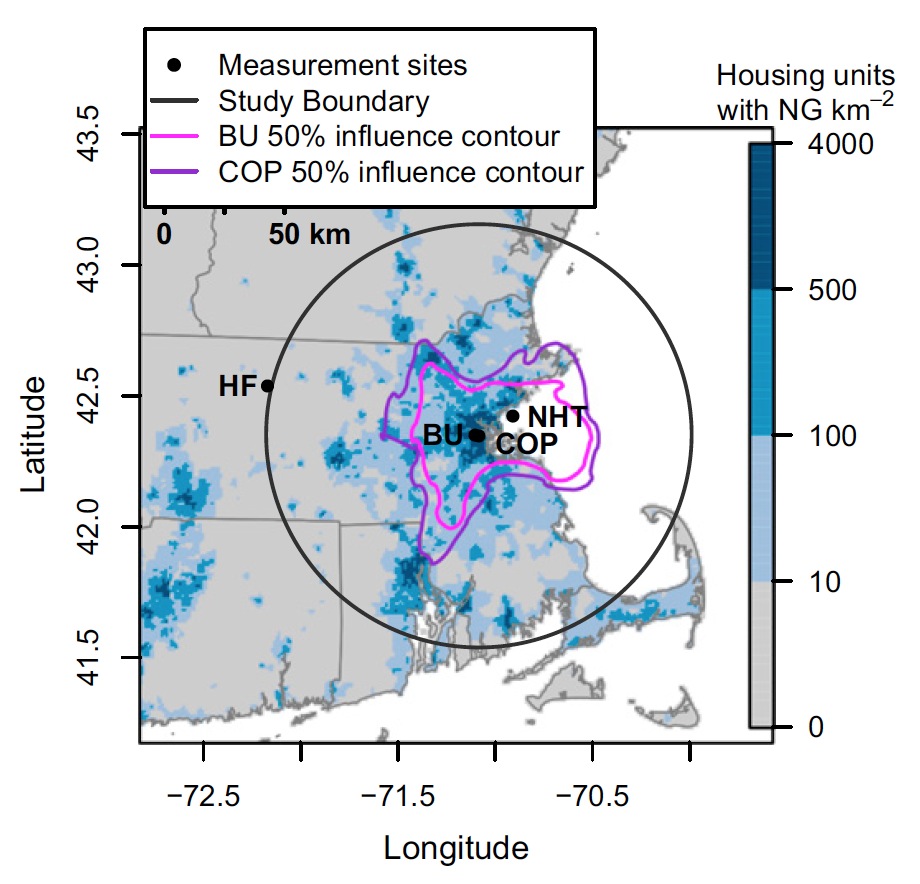PROCEEDINGS OF THE NATIONAL ACADEMY OF SCIENCES OF THE UNITED STATES OF AMERICA (PNAS)
Methane emissions from natural gas delivery and end use must be quantified to evaluate the environmental impacts of natural gas and to develop and assess the efficacy of emission reduction strategies. We report natural gas emission rates for 1 y in the urban region of Boston, using a comprehensive atmospheric measurement and modeling framework. Continuous methane observations from four stations are combined with a high-resolution transport model to quantify the regional average emission flux, 18.5 ± 3.7 (95% confidence interval) g CH4·m−2·y−1. Simultaneous observations of atmospheric ethane, compared with the ethane-to-methane ratio in the pipeline gas delivered to the region, demonstrate that natural gas accounted for ∼60–100% of methane emissions, depending on season. Using government statistics and geospatial data on natural gas use, we find the average fractional loss rate to the atmosphere from all downstream components of the natural gas system, including transmission, distribution, and end use, was 2.7 ± 0.6% in the Boston urban region, with little seasonal variability. This fraction is notably higher than the 1.1% implied by the most closely comparable emission inventory. Atmospheric methane (CH4) is an important greenhouse gas (1) and major contributor to elevated surface ozone concentrations worldwide (2). Current atmospheric CH4 concentrations are 2.5 times greater than preindustrial levels due to anthropogenic emissions from both biological and fossil fuel sources. The growth rate of CH4 in the atmosphere slowed beginning in the mid-1980s and plateaued in the mid-2000s, but growth has resumed since 2007. The factors responsible for the observed global increase and inter-annual trends, and the spatiotemporal distribution of sources, remain uncertain (3).
Losses of natural gas (NG) to the atmosphere are a significant component of anthropogenic CH4 emissions (3), with important implications for resource use efficiency, worker and public safety, air pollution, and human health (4), and for the climate impact of NG as a large and growing source of energy. A major focus area of the US Climate Action Plan is reduction of CH4 emissions (5), but implementation requires identification of dominant source types, locations, and magnitudes. A recent review and synthesis of CH4 emission measurements in North America, spanning scales of individual components to the continent, found that inventory methods consistently underestimate CH4 emissions, that fossil fuels are likely responsible for a large portion of the underestimate, and that significant fugitive emissions may be occurring from all segments of the NG system (6).
The present study quantifies CH4 fluxes from NG in the urbanized region centered on Boston. Elevated CH4 concentrations in urban environments have been documented around the world for decades (7) (SI Appendix, Table S1) and attributed to a variety of anthropogenic source types. Recent studies of urbanized regions in California, using diverse atmospheric observing and modeling approaches, consistently found that CH4 emission rates were larger than those estimated by regional bottom-up inventories (8–12). In Boston, elevated CH4 concentrations have been observed at street level and attributed to >3,000 NG pipeline leaks from antiquated infrastructure (13), but associated CH4 emission rates were not quantitatively assessed.
In this study, we combine four key quantities in an atmosphere-based analytical framework: (i) atmospheric CH4 enhancements above background (ΔCH4) were determined from measurements at a network of continuous monitoring stations, inside and upwind of the urban core (Fig. 1), for 12 mo in 2012–2013; (ii) the NG fraction of the observed ΔCH4 was quantified for cool and warm seasons by measuring atmospheric ethane (C2H6), a tracer of thermogenic CH4, and comparing ratios of C2H6 and CH4 in the atmosphere and in the pipeline gas flowing through the region; (iii) total CH4 emissions were derived from an atmospheric transport model, which quantitatively links surface fluxes with observed ΔCH4 using assimilated meteorology; and (iv) the fraction of delivered NG lost to the atmosphere was estimated by comparing CH4 emissions to spatially explicit data on NG consumption. The result encompasses NG losses from the entire urbanized region, including emissions from NG transmission, storage, distribution, end use, and liquefied NG importation.
Significance
Most recent analyses of the environmental impact of natural gas have focused on production, with very sparse information on emissions from distribution and end use. This study quantifies the full seasonal cycle of methane emissions and the fractional contribution of natural gas for the urbanized region centered on Boston. Emissions from natural gas are found to be two to three times larger than predicted by existing inventory methodologies and industry reports. Our findings suggest that natural-gas–consuming regions may be larger sources of methane to the atmosphere than is currently estimated and represent areas of significant resource loss.
Proceedings of the National Academy of Sciences of the United States of America
www.pnas.org
PNAS is one of the world’s most-cited and comprehensive multidisciplinary scientific journals, publishing more than 3,800 research papers annually. Established in 1914, PNAS publishes cutting-edge research, science news, Commentaries, Reviews, Perspectives, Colloquium Papers, and actions of the National Academy of Sciences.
Tags: Boston, Greenhouse Gases, MA, Massachusetts, Methane, National Academy of Sciences, Natural Gas, PNAS, Proceedings of the National Academy of Sciences of the United States of America







 RSS Feed
RSS Feed